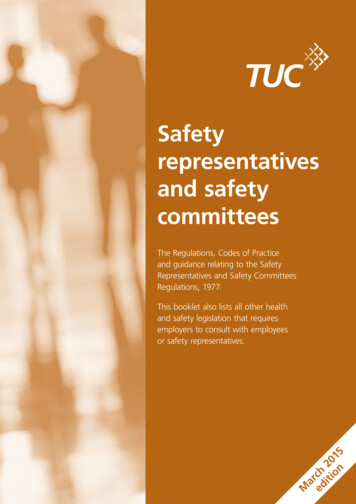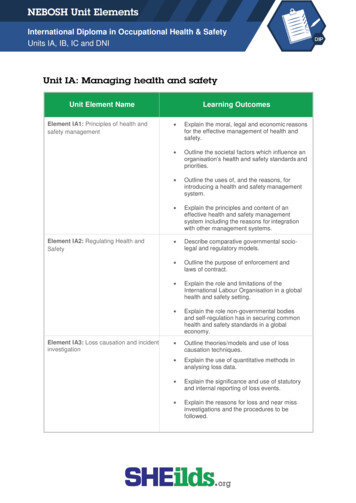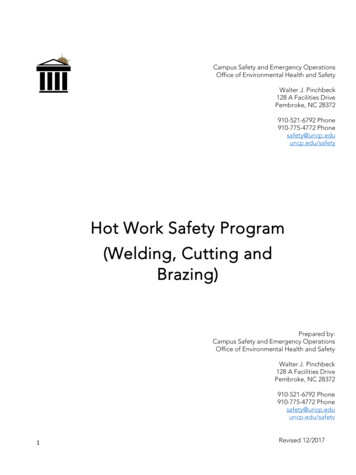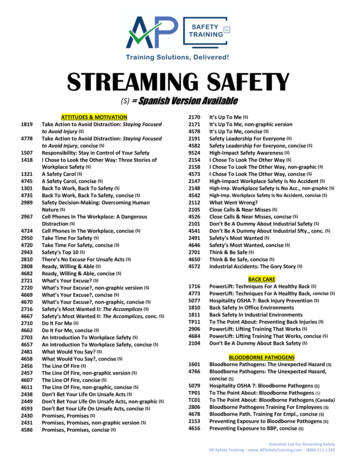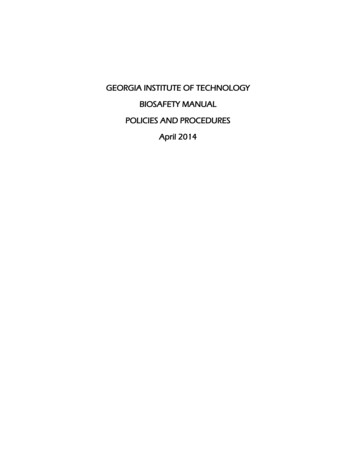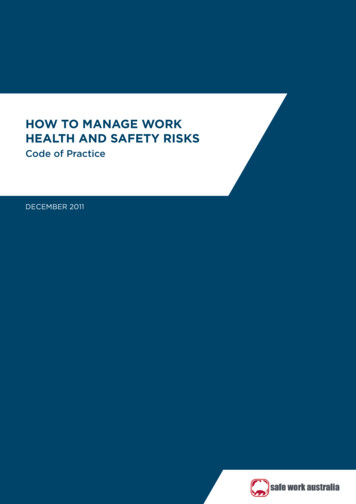
Transcription
Health and SafetyExecutiveTake care with oxygenFire and explosion hazards in the use of oxygenThis leaflet provides information on the fire and explosion hazards in the useof oxygen. It is for anyone who uses oxygen gas in cylinders.Hazards from oxygenOxygen gas in cylinders is used by many people at work and sometimes at home.It is used: in welding, flame cutting and other similar processes;for helping people with breathing difficulties;in hyperbaric chambers as a medical treatment;in decompression chambers for people who work in compressed air or indeep sea diving;for food preservation and packaging;in steelworks and chemical plants.The air we breathe contains about 21% oxygen. Without oxygen we would die in amatter of minutes. It may be hard to believe, but oxygen can also be dangerous.The dangers are fire and explosion.Oxygen behaves differently to air, compressed air, nitrogen and other inert gases. Itis very reactive. Pure oxygen, at high pressure, such as from a cylinder, can reactviolently with common materials such as oil and grease. Other materials may catchfire spontaneously. Nearly all materials including textiles, rubber and even metalswill burn vigorously in oxygen.Even a small increase in the oxygen level in the air to 24% can create a dangeroussituation. It becomes easier to start a fire, which will then burn hotter and morefiercely than in normal air. It may be almost impossible to put the fire out. A leakingvalve or hose in a poorly ventilated room or confined space can quickly increasethe oxygen concentration to a dangerous level.The main causes of fires and explosions when using oxygen are: oxygen enrichment from leaking equipment;use of materials not compatible with oxygen;use of oxygen in equipment not designed for oxygen service;incorrect or careless operation of oxygen equipment.Risk assessmentEmployers are legally required to assess the risks in the workplace, and take allreasonably practicable precautions to ensure the safety of workers and membersof the public. A careful examination of the risks from using oxygen should beincluded in the risk assessment.1 of 6 pages
Health and SafetyExecutiveBeware of oxygen enrichmentOxygen enrichment is the term often used to describe situations where the oxygenlevel is greater than in air. Oxygen is colourless, odourless and tasteless. Thepresence of an oxygen enriched atmosphere cannot be easily detected by thehuman senses.The main danger to people from an oxygen enriched atmosphere is that clothing orhair can easily catch fire, causing serious or even fatal burns. For example, peoplecan easily set their clothing and bedding on fire by smoking while receiving oxygentreatment for breathing difficulties.Smoking should be forbidden where oxygen is being used.Oxygen enrichment is often the result of: leaks from damaged or poorly maintained hoses, pipes and valves;leaks from poor connections;opening valves deliberately or accidentally;not closing valves properly after use;using an excess of oxygen in welding, flame cutting ora similar process;poor ventilation where oxygen is being used.Consequently, the main ways to prevent oxygen enrichment are to keep oxygenequipment in good condition and to take care when using it. Good ventilation willalso reduce the risk of oxygen enrichment.Oxygen enrichment can also result from the misuse of oxygen. Never use oxygenfor: cooling or refreshing the air in confined spaces;dusting benches, machinery or clothing.If oxygen enrichment from an oxygen leak is suspected, the oxygen supply shouldbe turned off. Cigarettes and open flames should be extinguished. The roomshould be well ventilated and the source of the leak identified and repaired. It ispossible that oxygen may contaminate any clothing in the area. If this is suspected,the clothing should preferably be removed and taken outside for airing andventilating.Confined spacesSome of the most serious oxygen related incidents have involved damaged oxygenhoses leaking into confined spaces, where welding and burning operations weretaking place. The workers’ oxygen enriched clothing caught fire, causing serious orfatal injuries.Gas cylinders should not be taken into confined spaces; the gas can be fed in byusing hoses. The hoses should be removed from the confined space when work isfinished or suspended, such as at the end of each day. Where this is notpracticable, the hoses should be disconnected from the gas supply at the cylinderor manifold.Where the risk from oxygen enrichment is high, such as in a confined space or apoorly ventilated room, the use of oxygen monitoring equipment is advisable.Take care with oxygen2 of 6 pages
Health and SafetyExecutiveNever use materials incompatible with oxygenSome materials react explosively if they come into contact with pure oxygen at highpressure. Other materials may catch fire spontaneously. Such materials areincompatible with oxygen.Equipment designed for oxygen service is made from materials and componentsthat have been tested and proved to be compatible, and are safe for the purpose.The reasons for a particular design and choice of material are not always obvious.Using substitute materials or components, which appear to be similar but are notproven to be oxygen compatible, is extremely dangerous and has caused manyaccidents.You need to take care when replacing:O rings and gasketsThere are hundreds of different types of rubber and elastomer, and most are notcompatible with oxygen.Metal componentsMany metals and alloys are not suitable for use with oxygen.Pressure regulatorsYou must ensure that the pressure rating of the regulator is not less than the fullcylinder supply pressure. Pressure regulators for gas welding equipment shouldcomply with BS EN ISO 2503 and for medical gases with BS EN 738. Manyexisting regulators were made to standards which have now been withdrawn suchas BS 5741, BS 7650 and BS EN 585. These regulators may not be suitable forpressures above 200 bar. If in doubt, check with the supplier or manufacturer.Oxygen hosesThe flexible oxygen hose used for welding, etc, should comply with BS EN 559 orBS EN 739.LubricantsAs a rule, lubricants should be avoided. Only lubricants that are made for oxygenservice, and are specified by the equipment supplier, should be used.TapeTape should be avoided. Only tape that is marked as suitable for oxygen service,and is specified by the equipment supplier, should be used.Other componentsIn some cases, the materials may appear to be compatible but the shape andconfiguration of components may be important in minimising the fire risk. Onlycomponents approved by the manufacturer should be used when maintainingoxygen equipment.You should always ensure that high pressure oxygen systems are designed,constructed, installed and commissioned by competent people who havespecialised knowledge of the subject. All oxygen apparatus and equipment mustbe properly identified with the gas name and safe working pressure.Take care with oxygen3 of 6 pages
Health and SafetyExecutiveNever use oxygen in equipment not designed for itMany serious accidents have been caused by using oxygen instead of other gasessuch as air, compressed air or nitrogen. Oxygen can react explosively with oils andgreases. People have been injured or even killed when pumps, engines, tyres andpressure equipment have been blown apart by the explosion. Oxygen can alsocause other materials to ignite spontaneously. The resulting fire can cause damageto equipment and injury to people.You should never use oxygen for: driving pneumatic tools;inflating vehicle tyres;pressurising and purging systems;replacing air or inert gas;starting diesel engines.Oxygen must not be introduced into any equipment unless it has been designedfor oxygen service by competent people with specialist knowledge.Take care with oxygen cylinders and equipmentIf oxygen cylinders and equipment are used carelessly or incorrectly, then a firemay result. All users of oxygen should know and understand the dangers, andshould receive training in the use of oxygen equipment.There are a number of precautions to follow when using oxygen equipment.Oxygen cylindersYou should always: handle oxygen cylinders carefully. Use a purpose built trolley to move them;keep cylinders chained or clamped to prevent them from falling over;store oxygen cylinders when not in use in a well ventilated storage area orcompound, away from combustible materials and separated from cylinders offlammable gas.Oxygen equipmentYou should always: open the valve slowly. Rapid opening, particularly of cylinder valves, can resultin momentarily high oxygen velocities. Any particles will be pushed through thesystem very quickly, causing frictional heat. Alternatively, if the system has adead end such as where a pressure regulator is connected to an oxygencylinder, heat can be generated through compression of the oxygen. Bothcases can result in a fire;ensure that the pressure adjusting screw of the pressure regulator is fullyunwound, so that the regulator outlet valve is closed before opening theoxygen cylinder valve, particularly when opening the cylinder valve for the firsttime after changing cylinders;ensure that cylinder valves are closed and piped supplies isolated wheneverwork is stopped. Do not try to cut off the supply of oxygen by nipping orkinking flexible hose when changing equipment, eg blowpipes;Take care with oxygen4 of 6 pages
Health and SafetyExecutive maintain hoses and other equipment in good condition. Leak tests can becarried out easily using a proprietary spray or liquid solution that is certified foruse on oxygen systems. Soap or liquids that may contain grease shouldnot be used.CleanlinessYou should always: keep oxygen equipment clean. Contamination by particulate matter, dust, sand,oils, greases or general atmospheric debris is a potential fire hazard. Portableequipment is particularly susceptible to contamination, and precautions shouldbe taken to keep it clean;use clean hands or gloves when assembling oxygen equipment, eg attachingthe pressure regulator, making connections;wear suitable clean clothing, free from oil and easily combustible contaminants.General precautionsYou should always: ensure that ventilation is adequate;check that fire extinguishers are in good condition and ready for use;check that escape routes are clear.Summary of advice1Be aware of the dangers of oxygen if in doubt, ask. 2Prevent oxygen enrichment by ensuring that equipment is leak tight and ingood working order. 3Check that ventilation is adequate. 4Always use oxygen cylinders and equipment carefully and correctly. 5Always open oxygen cylinder valves slowly. 1Do not smoke where oxygen is being used. 2Never use replacement parts which have not been specifically approved foroxygen service. 3Never use oxygen equipment above the pressures certified by themanufacturer. 4Never use oil or grease to lubricate oxygen equipment. 5Never use oxygen in equipment which is not designed for oxygen service. Take care with oxygen5 of 6 pages
Health and SafetyExecutiveReferencesFive steps to risk assessment INDG163(rev2) HSE Books 2006 (single copy free orpriced packs of 10 ISBN 978 0 7176 6189 3) www.hse.gov.uk/pubns/indg163.pdfBS EN ISO 2503: 1998 Gas welding equipment. Pressure regulators for gascylinders used in welding, cutting and allied processes up to 300 bar BritishStandards InstitutionBS EN ISO 10524 1:2006 Pressure regulators for use with medical gases.Pressure regulators and pressure regulators with flow metering devices BritishStandards InstitutionBS EN 738 3:1999 Pressure regulators for use with medical gases. Pressureregulators integrated with cylinder valves British Standards InstitutionBS EN 559:2003 Gas welding equipment. Rubber hoses for welding, cutting andallied processes British Standards InstitutionBS EN 739:1998 Low pressure hose assemblies for use with medical gases BritishStandards InstitutionSafe work in confined spaces. Confined Spaces Regulations 1997. Approved Codeof Practice, Regulations and guidance L101 HSE Books 1997ISBN 978 0 7176 1405 9The safe use of compressed gases in welding, flame cutting and allied processesHSG139 HSE Books 1997 ISBN 978 0 7176 0680 1Industrial gas cylinder manifolds and distribution pipework/pipelines (excludingacetylene). CP4(rev3) Code of Practice British Compressed Gases Association2005The safe use of oxy fuel gas equipment (individual portable or mobile cylindersupply) CP7(rev4) Code of Practice British Compressed Gases Association 2004Guidance for the storage of transportable gas cylinders for industrial use GuidanceNote GN2(rev3) British Compressed Gases Association 2005While every effort has been made to ensure the accuracy of the references listed inthis publication, their future availability cannot be guaranteed.HSE priced and free publications are available by mail order from: HSE Books,PO Box 1999, Sudbury, Suffolk CO10 2WA Tel: 01787 881165 Fax: 01787 313995Website: www.hsebooks.co.ukHSE priced publications are also available from bookshops, and free leaflets can bedownloaded from HSE’s website www.hse.gov.ukFor information about health and safety ring HSE’s Infoline Tel: 0845 345 0055Fax: 0845 408 9566 Textphone: 0845 408 9577 e mail: hse.infoline@natbrit.com orwrite to HSE Information Services, Caerphilly Business Park, Caerphilly CF83 3GG.This leaflet contains notes on good practice which are not compulsory butwhich you may find helpful in considering what you may need to do. Crown copyright This publication may be freely reproduced, except foradvertising, endorsement or commercial purposes. First published 08/99. Pleaseacknowledge the source as HSE.Published by the Health and Safety ExecutiveHSE8(rev2)Reprinted 02/086 of 6 pages
Where the risk from oxygen enrichment is high, such as in a confined space or a poorly ventilated room, the use of oxygen monitoring equipment is advisable. Take care with oxygen 2 of 6 pages. Health and Safety Executive Never use materials incompatible with oxygen Some materials react explosively if they come into contact with pure oxygen at high pressure. Other materials may catch fire .

